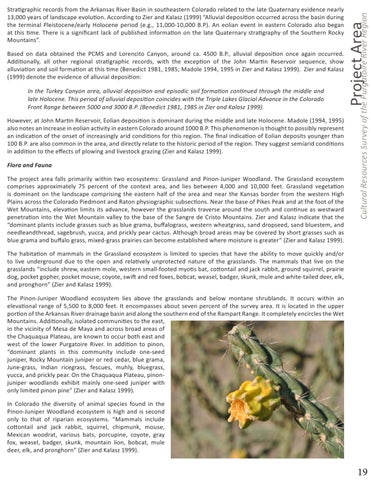In the Turkey Canyon area, alluvial deposition and episodic soil formation continued through the middle and late Holocene. This period of alluvial deposition coincides with the Triple Lakes Glacial Advance in the Colorado Front Range between 5000 and 3000 B.P. (Benedict 1981, 1985 in Zier and Kalasz 1999). However, at John Martin Reservoir, Eolian deposition is dominant during the middle and late Holocene. Madole (1994, 1995) also notes an increase in eolian activity in eastern Colorado around 1000 B.P. This phenomenon is thought to possibly represent an indication of the onset of increasingly arid conditions for this region. The final indication of Eolian deposits younger than 100 B.P. are also common in the area, and directly relate to the historic period of the region. They suggest semiarid conditions in addition to the effects of plowing and livestock grazing (Zier and Kalasz 1999). Flora and Fauna The project area falls primarily within two ecosystems: Grassland and Pinon-Juniper Woodland. The Grassland ecosystem comprises approximately 75 percent of the context area, and lies between 4,000 and 10,000 feet. Grassland vegetation is dominant on the landscape comprising the eastern half of the area and near the Kansas border from the western High Plains across the Colorado Piedmont and Raton physiographic subsections. Near the base of Pikes Peak and at the foot of the Wet Mountains, elevation limits its advance, however the grasslands traverse around the south and continue as westward penetration into the Wet Mountain valley to the base of the Sangre de Cristo Mountains. Zier and Kalasz indicate that the “dominant plants include grasses such as blue grama, buffalograss, western wheatgrass, sand dropseed, sand bluestem, and needleandthread, sagebrush, yucca, and prickly pear cactus. Although broad areas may be covered by short grasses such as blue grama and buffalo grass, mixed-grass prairies can become established where moisture is greater” (Zier and Kalasz 1999).
Project Area
Based on data obtained the PCMS and Lorencito Canyon, around ca. 4500 B.P., alluvial deposition once again occurred. Additionally, all other regional stratigraphic records, with the exception of the John Martin Reservoir sequence, show alluviation and soil formation at this time (Benedict 1981, 1985; Madole 1994, 1995 in Zier and Kalasz 1999). Zier and Kalasz (1999) denote the evidence of alluvial deposition:
Cultural Resources Survey of the Purgatoire River Region
Stratigraphic records from the Arkansas River Basin in southeastern Colorado related to the late Quaternary evidence nearly 13,000 years of landscape evolution. According to Zier and Kalasz (1999) “Alluvial deposition occurred across the basin during the terminal Pleistocene/early Holocene period (e.g., 11,000-10,000 B.P). An eolian event in eastern Colorado also began at this time. There is a significant lack of published information on the late Quaternary stratigraphy of the Southern Rocky Mountains”.
The habitation of mammals in the Grassland ecosystem is limited to species that have the ability to move quickly and/or to live underground due to the open and relatively unprotected nature of the grasslands. The mammals that live on the grasslands “include shrew, eastern mole, western small-footed myotis bat, cottontail and jack rabbit, ground squirrel, prairie dog, pocket gopher, pocket mouse, coyote, swift and red foxes, bobcat, weasel, badger, skunk, mule and white-tailed deer, elk, and pronghorn” (Zier and Kalasz 1999). The Pinon-Juniper Woodland ecosystem lies above the grasslands and below montane shrublands. It occurs within an elevational range of 5,500 to 8,000 feet. It encompasses about seven percent of the survey area. It is located in the upper portion of the Arkansas River drainage basin and along the southern end of the Rampart Range. It completely encircles the Wet Mountains. Additionally, isolated communities to the east, in the vicinity of Mesa de Maya and across broad areas of the Chaquaqua Plateau, are known to occur both east and west of the lower Purgatoire River. In addition to pinon, “dominant plants in this community include one-seed juniper, Rocky Mountain juniper or red cedar, blue grama, June-grass, Indian ricegrass, fescues, muhly, bluegrass, yucca, and prickly pear. On the Chaquaqua Plateau, pinonjuniper woodlands exhibit mainly one-seed juniper with only limited pinon pine” (Zier and Kalasz 1999). In Colorado the diversity of animal species found in the Pinon-Juniper Woodland ecosystem is high and is second only to that of riparian ecosystems. “Mammals include cottontail and jack rabbit, squirrel, chipmunk, mouse, Mexican woodrat, various bats, porcupine, coyote, gray fox, weasel, badger, skunk, mountain lion, bobcat, mule deer, elk, and pronghorn” (Zier and Kalasz 1999).
19
